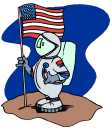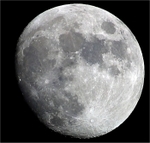By Laura G. Smith

|
Race to the Moon!
By Laura G. Smith |

|
 1 On July 20, 1969, millions of people gathered around their TV sets. They watched an amazing event! It was the day a man walked on the moon for the very first time! That man was American astronaut Neil Armstrong. As he stepped onto the rocky surface of the moon, Mr. Armstrong spoke the famous words, "That's one small step for man, one giant leap for mankind."
1 On July 20, 1969, millions of people gathered around their TV sets. They watched an amazing event! It was the day a man walked on the moon for the very first time! That man was American astronaut Neil Armstrong. As he stepped onto the rocky surface of the moon, Mr. Armstrong spoke the famous words, "That's one small step for man, one giant leap for mankind." |
Create Weekly Reading Books
Prepare for an entire week at once! |
| Leave your feedback on Race to the Moon! (Grades 5-6) (use this link if you found an error in the story) |
 |
Solar System and Planets
|
 |
Free Moon Worksheets | edHelper.com
|
 |
Science
|